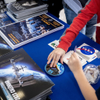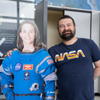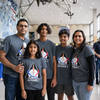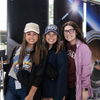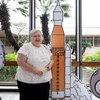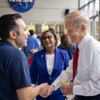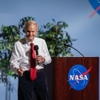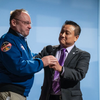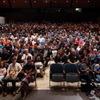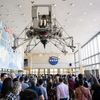Orion Makes a Splash, Captivates the Local Community
NASA’s Orion spacecraft splashed down in the Pacific Ocean, west of Baja California, at 11:40 a.m. CST Sunday after a record-breaking mission, traveling more than 1.4 million miles on a path around the Moon and returning safely to Earth, completing the Artemis I flight test.
In Houston at NASA’s Johnson Space Center, Johnson Director Vanessa Wyche welcomed crowds of team members and their families and friends to the Teague Auditorium and lobby to watch the history-making event unfold.
Leading up to the main event, NASA leaders took to the stage to share more about the Artemis I mission, which prefaces future flights with astronauts aboard. Special guests included NASA Associate Administrator Bob Cabana, NASA Associate Administrator for Exploration Systems Development Jim Free, Orion Program Manager Howard Hu, NASA astronaut Mike Fincke (who is also the Boeing CFT-100 joint operations commander), and Tim Otterson, manager of the Orion Crew and Service Module Office. Attendees enjoyed refreshments and Orion giveaways, as well as the successful conclusion of Orion’s inaugural test flight.
Below, relive the moment when the crowd goes wild in the auditorium as Orion makes its debut splash.
Splashdown is the final milestone of the Artemis I mission that began with a liftoff of NASA’s Space Launch System (SLS) rocket on Nov. 16 from Launch Pad 39B at NASA’s Kennedy Space Center in Florida. Over the course of 25.5 days, NASA tested Orion in the harsh environment of deep space before flying astronauts on Artemis II.
During the mission, Orion performed two lunar flybys, coming within 80 miles of the lunar surface. At its farthest distance during the mission, Orion traveled nearly 270,000 miles from our home planet, more than 1,000 times farther than where the International Space Station orbits Earth, to intentionally stress systems before flying crew.
During the flight test, Orion stayed in space longer than any spacecraft designed for astronauts has done without docking to a space station. While in a distant lunar orbit, Orion surpassed the record for distance traveled by a spacecraft designed to carry humans, previously set during Apollo 13.
Artemis I was the first integrated test of NASA’s deep space exploration systems — the Orion spacecraft, SLS rocket, and the supporting ground systems — and was supported by thousands of people around the world, from contractors who built the spacecraft and rocket, and the ground infrastructure needed to launch them, to international and university partners, to small businesses supplying subsystems and components.
Through Artemis missions, NASA will land the first woman and the first person of color on the surface of the Moon, paving the way for a long-term lunar presence and serving as a steppingstone for astronauts on the way to Mars.
Enjoy more photos from the event by clicking though the gallery below.








